HP BIOS Tools

With the HP BIOS Tools OS 12 app, you can manage and update the BIOS, BIOS settings, and BIOS password of supported Hewlett-Packard (HP) devices using the IGEL Universal Management Suite (UMS).
You can use profiles and specific device commands to handle any number of devices.
BIOS Updates at Your Own Risk
IGEL is offering and supporting the BIOS Update mechanism - BIOS updates are performed at your own risk!
The BIOS update mechanism is functional even with Secure Boot enabled and when a BIOS password is set.
Supported Devices
The HP BIOS Tools app is supported for the following HP models:
t540
Pro t550
t640
Elite t655
t740
Elite t755
Elite mt645 G7 (HP BIOS Tools 2.0.0 or higher)
Elite mt645 G8 (HP BIOS Tools 2.0.0 or higher)
Pro mt440 G3 (HP BIOS Tools 2.0.0 or higher)
Elite t660 (HP BIOS Tools 2.0.1 or higher)
Apps That Are Installed with HP BIOS Tools 2.0.0
When HP BIOS Tools 2.0.0 is installed, the following apps are also installed automatically:
Optional Kernel Modules for IGEL OS 12 Systems (optional_kernel_modules)
The Base System will be updated to IGEL OS Base System 12.5.0 if not already done
Requirements
UMS 12.01 or higher
Supported devices with IGEL OS Base System 12.01.100 or higher
The IGEL OS Base System needs to be installed directly on the device. The HP BIOS Tools app is unsupported if the IGEL OS boots from a UD Pocket.
A Windows machine for creating the password file
Creating a Profile
If you have not done so already, create a profile for your app.
In the UMS Web App, go to APPS and search for “BIOS” to find the HP BIOS Tools app.


Click Create New Profile.

Define a name for your profile.
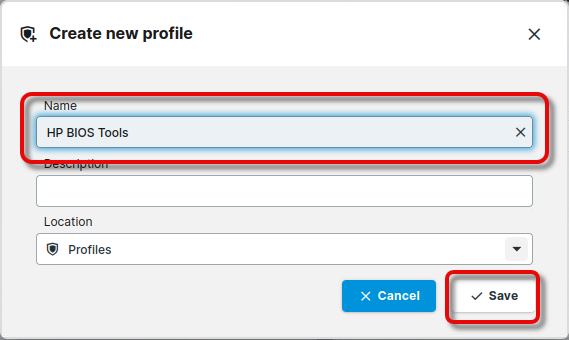
We will use this profile for every use case of the HP BIOS Tools app.
Assigning the Profile to Your Devices
In the field Assign device, enter the name of the device or device directory for which you want to use the HP BIOS Tools app.

Select Assign and apply changes on reboot.

Setting up the File Source
Since not only updating the BIOS but also its configuration is done using files, we need to set up a file source that is reachable by all devices.
The creation of the files is described in the relevant sections. The procedures described here are the same for all files in question, that is:
BIOS update file
BIOS settings file
BIOS password file
Security Note
If you use password files, ensure the password file is not accessible longer than necessary.
Using an External Source (HTTP/HTTPS)
If you want to deploy the BIOS update file, the BIOS settings file, and the password file from an external source, you can set up an HTTP/HTTPS server.
You can secure the file access using a username and password. To achieve this, you must configure your devices to provide a username and password:
→ In your HP BIOS Tools profile, edit Apps > HP BIOS Tools > Password as follows:
Download username: Username required for downloading
Download password: Password required for downloading
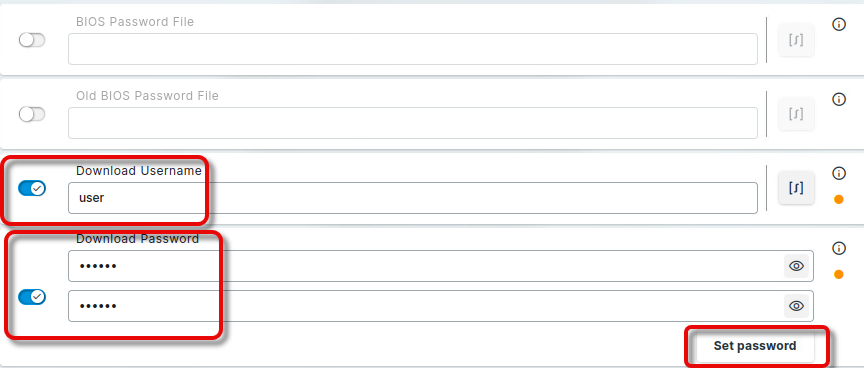
Using a Local Storage Device (USB)
For more information on how to use a storage device with IGEL OS, see Storage Hotplug in IGEL OS 12.
Using UMS File Transfer
The following example shows how to use the UMS file transfer facility for file deployment. In this example, a BIOS update file is provided; the procedure is the same for settings and password files.
In the UMS Web App, go to Configuration Objects, select the icon for files, and then the icon for uploads.
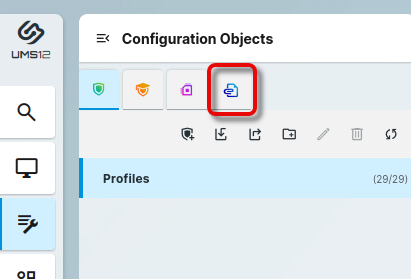

Choose the file on your system via drag & drop or via Browse files….

In the field Device file location, define the local path in which the file will be stored on the device, e.g.
/tmp/. Afterward, click Finish upload.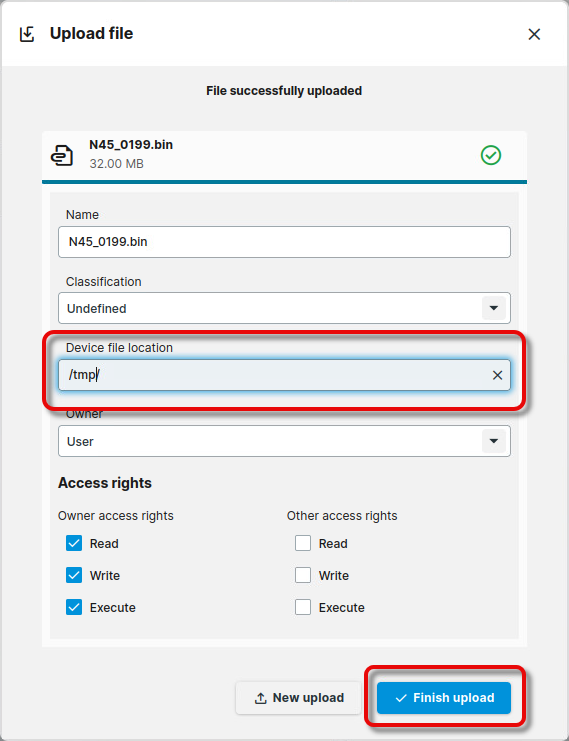
Assign the file to your devices by assigning it to the profile we have created beforehand.
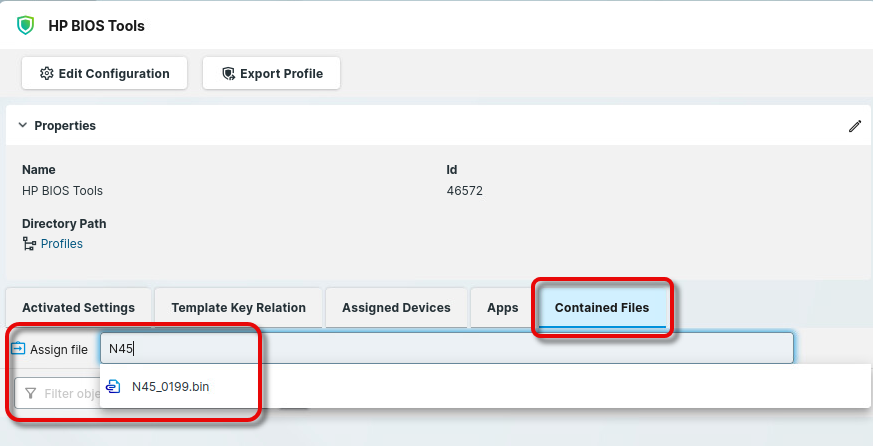

If Your BIOS is Password-Protected: Provide a BIOS Password File to Make Changes
If your BIOS is protected by a password, a valid password file must be provided to allow any kind of changes to the BIOS. For this purpose, you must create a password file and make it available to the device.
As a precondition, you must know the BIOS password of your devices, of course.
On a Windows machine, download the password tool from https://ftp.ext.hp.com/pub/caps-softpaq/cmit/HPQPswd.htmland install it.
Create a password file with the known password and make it available as described under Setting up the File Source.
In the BIOS Tools profile, go to Apps > HP BIOS Tools > Password and enter the file path.
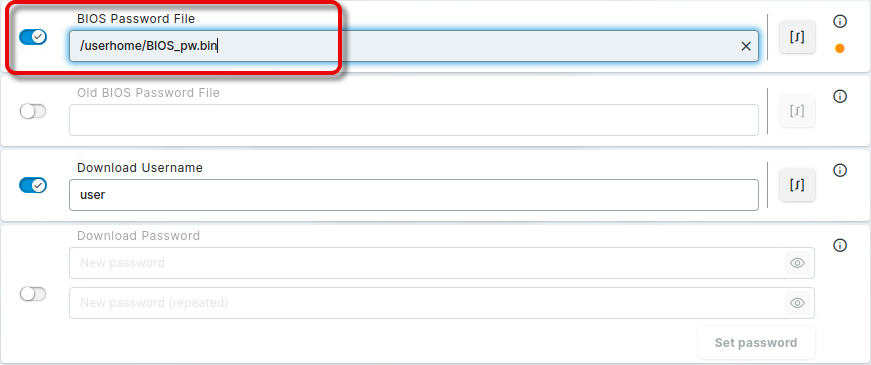
Updating the BIOS
Some target devices might power off instead of rebooting. This effect has been observed with the following models:
Elite mt645 G7
Elite mt645 G8
Getting the BIOS Update File from HP
Open https://support.hp.com/, select your device, click Software, Drivers, and Firmware, and follow the steps.
Download the file (example:
sp126570.exe) and unzip it.In the directories created by unzipping, look for a file with the ending
.bin, for instance,M44_0103.bin, and store it in a location that is reachable from your UMS machine.
Making the BIOS Update File Available
→ Make the BIOS update file available to your devices; see Setting up the File Source.
Configuring the Devices for the BIOS Update
You can replace the current BIOS with a higher version, but not the same version. Therefore, restoring the original BIOS that had been installed on the device before is not possible.
Moreover, it is not possible to downgrade the BIOS.
→ In the BIOS Tools profile, go to Apps > HP BIOS Tools > Update, make the following edits, and save your settings.
BIOS update file: Local path or URL of the BIOS update file

Triggering the BIOS Update
In the UMS, select the relevant devices (or directory), open the context menu, and select Specific Device Command.
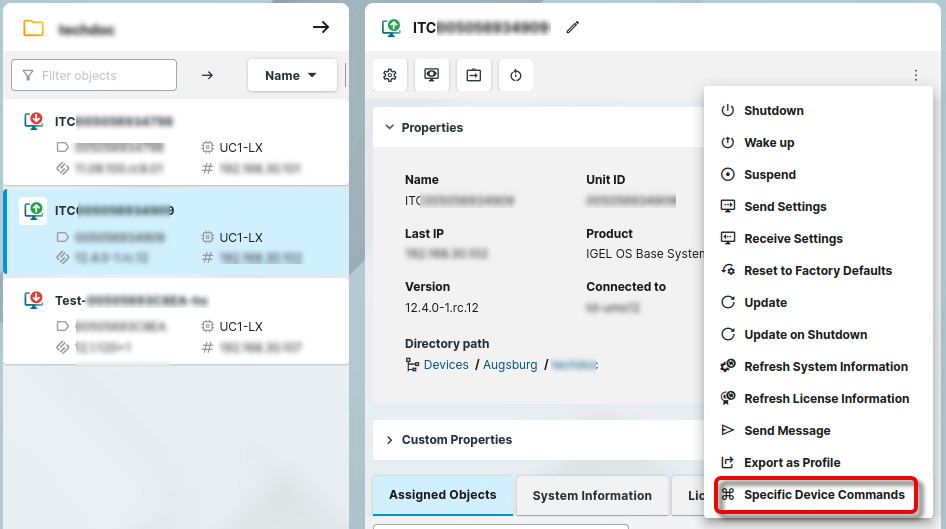
Select BIOS - Trigger update and click Execute.
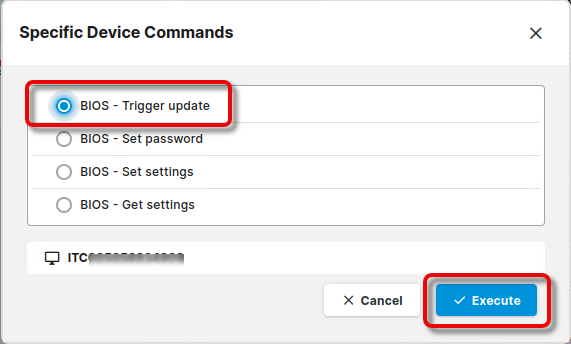
The target devices receive a reboot command; a corresponding message is displayed.
The timespan before the BIOS logo and the progress bar is shown might be significantly longer than usual. Please ensure that the device remains powered on until the update process is finished.
Changing the BIOS Settings
To change the BIOS settings of the device, a settings file needs to be transferred to the device with the setting updates in the correct syntax.
In the section below, we describe in detail the easiest way to do this, that is:
Getting the BIOS settings file from the device through scp. This way you get the correct base file.
Editing the transferred file.
Transferring the file back to the device or device directory. This way you can distribute the update in batches.
Defining the Paths for Exchanging the BIOS Settings Files
First, we will define a local directory path in which the HP BIOS Tools app will store the current BIOS settings as a file and a local directory path in which the edited settings file will be stored so the app can apply them to the device's BIOS.
→ In the BIOS Tools profile, go to Apps > HP BIOS Tools > Settings, make the following edits, and save your settings.
Set BIOS settings file: Path to the file path.
Get BIOS settings file: Path to the file folder with the current BIOS settings file. The filename will be
bios_settings_<unit_id>
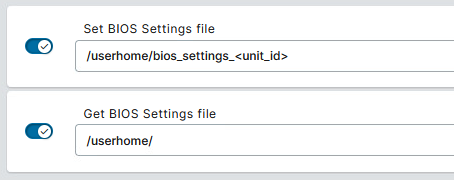
Generating the Current BIOS Settings File
In the UMS, select the relevant devices (or directory), open the context menu, and select Specific Device Commands.
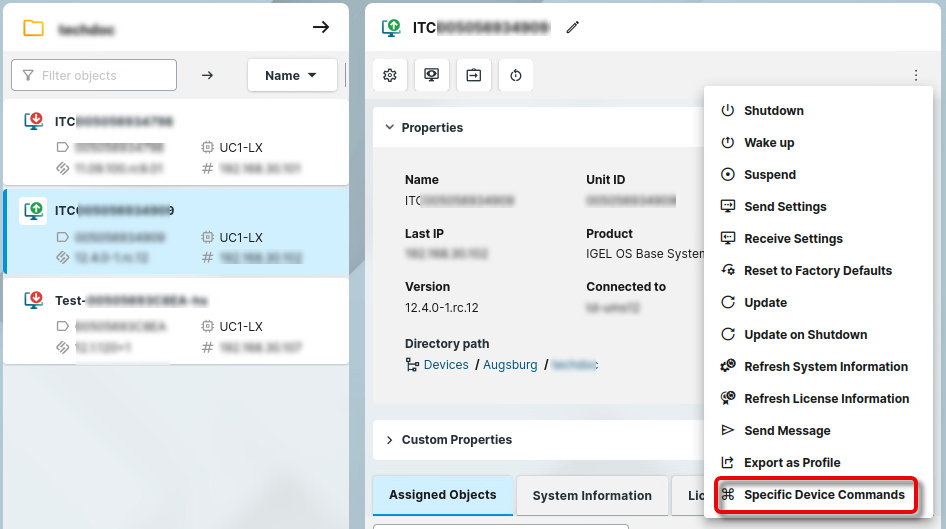
Select BIOS - Get settings and click Execute.
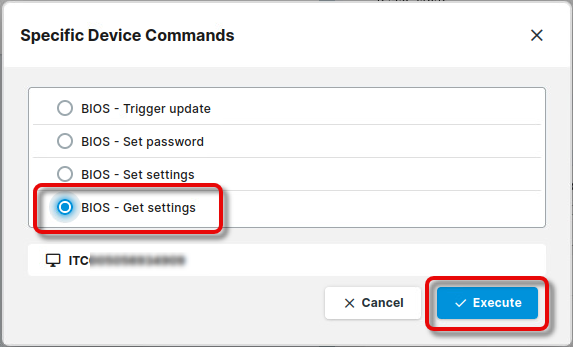
Transferring and Editing the BIOS Settings File
Enable SSH as described in https://kb.igel.com/en/igel-os-base-system/12.6.1/ssh-access-in-igel-os-12 .
Use scp from a linux or windows terminal:
scp username@remote:/path /localpath
Depending on the SSH access configuration,
usernamecould beroot,ruser, oruser.remoteis the IP address of the OS 12 device./pathit the path to the BIOS settings file on the OS 12 device/localpathis the path to where the file will be saved locally
Download and install the HP BIOS Configuration Utility. For information on the download source and the use of the utility, see https://ftp.ext.hp.com/pub/caps-softpaq/cmit/whitepapers/BIOS_Configuration_Utility_User_Guide.pdf.
Edit the configuration file as desired.
Regarding the configuration file, please note the following:
It is recommended to use a text editor under Unix/Linux for editing. This ensures that the correct line feeds are used and that the characters are encoded correctly (UTF-8).
Make sure that the BIOS settings file is formatted properly and that the REPSET format is respected. For further information, see https://ftp.ext.hp.com/pub/caps-softpaq/cmit/whitepapers/BIOS_Configuration_Utility_User_Guide.pdf
It is sufficient to specify only those BIOS setting you want to change so that your edited file contains snippets instead of all possible settings.
Save the settings file. Make the edited file available as described under Setting up the File Source.
Deploying the Changed Settings on the Device
In the UMS, select the relevant devices (or directory), open the context menu, and select Specific Device Command.
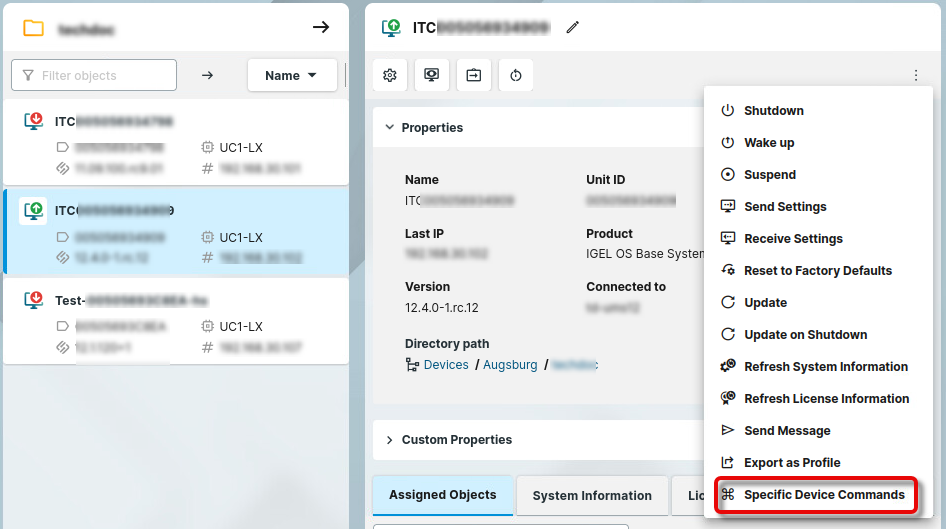
Select BIOS - Set settings and click Execute.
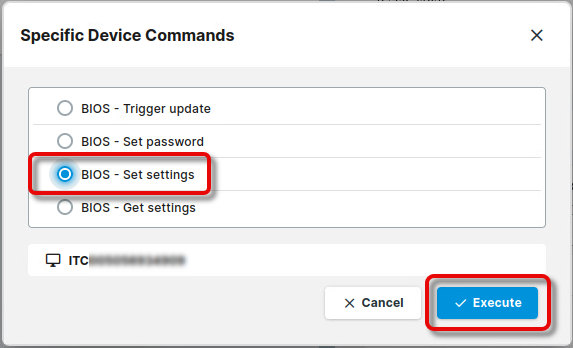
Setting a BIOS Password to Protect Your BIOS
If your BIOS is not protected by a password yet and you want to secure it with a BIOS password, proceed as follows.
On a Windows machine, download the password tool from https://ftp.ext.hp.com/pub/caps-softpaq/cmit/HPQPswd.html and install it.
Create a password file with the new password and make it available as described under Setting up the File Source.
In the BIOS Tools profile, go to Apps > HP BIOS Tools > Password and enter the file path.

In the UMS, select the relevant devices (or directory), open the context menu, and select Specific Device Commands.

Select BIOS - Set password and click Execute.
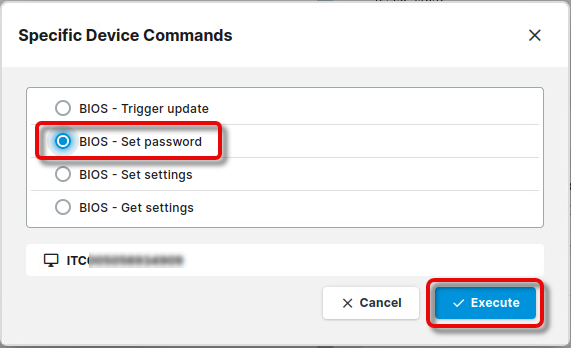
Changing the BIOS Password
If your devices already have a BIOS password and you want to change it, proceed as follows.
On a Windows machine, download the password tool from https://ftp.ext.hp.com/pub/caps-softpaq/cmit/HPQPswd.html and install it.
Create a password file with the current password and make it available as described under Setting up the File Source.
Create a password file with the new password and make it available as described under Setting up the File Source.
In the BIOS Tools profile, go to Apps > HP BIOS Tools > Password, make the following edits, and save your settings.
BIOS password file: File path of the new password file
Old BIOS password file: File path of the current password file
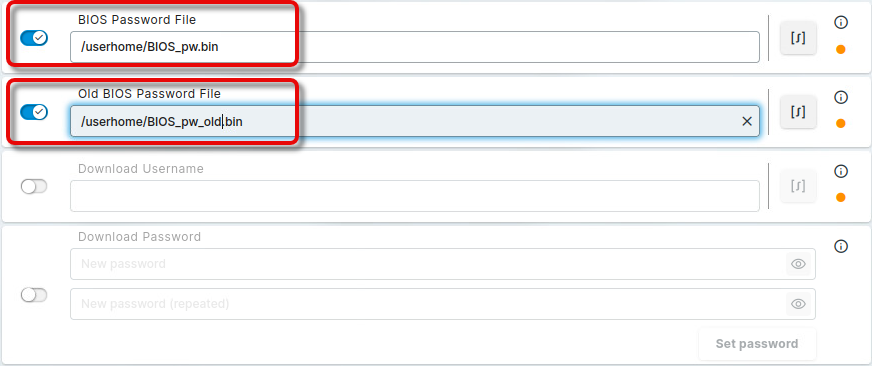
In the UMS, select the relevant devices (or directory), open the context menu, and select Specific Device Command.
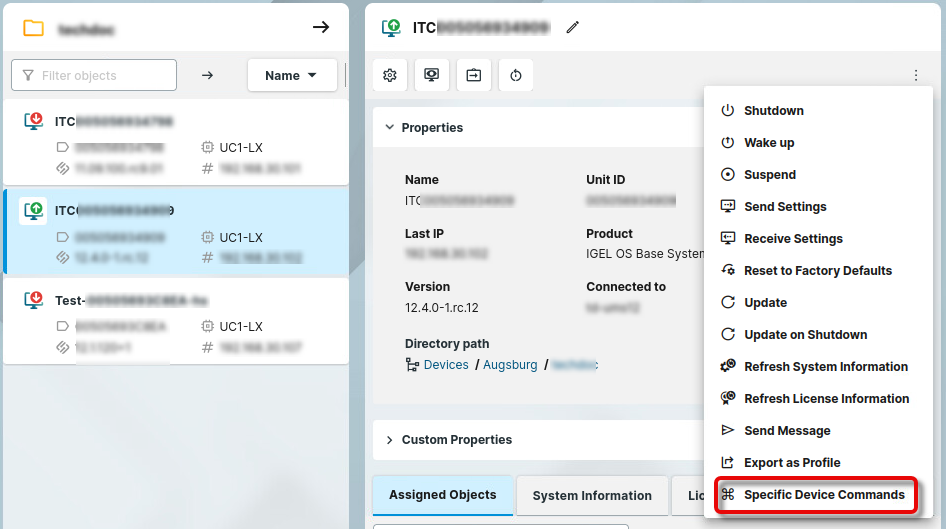
Select BIOS - Set password and click Execute.

Resetting the BIOS Password (Removing Password Protection)
If your devices have a BIOS password and you want to reset it so that the BIOS will be accessible without a password, proceed as follows.
On a Windows machine, download the password tool from https://ftp.ext.hp.com/pub/caps-softpaq/cmit/HPQPswd.html and install it.
Create a password file with the old password and make it available as described under Setting up the File Source.
In the BIOS Tools profile, go to Apps > HP BIOS Tools > Password, make the following edits, and save your settings.
BIOS password file: Enter
RESET_PASSWORDOLD BIOS password file:

In the UMS, select the relevant devices (or directory), open the context menu, and select Specific Device Commands.
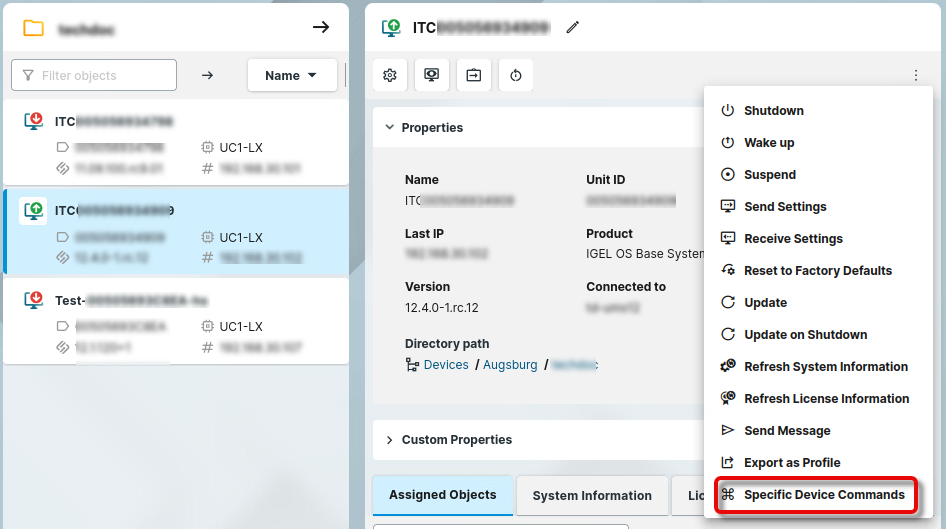
Select BIOS - Set password and click Execute.
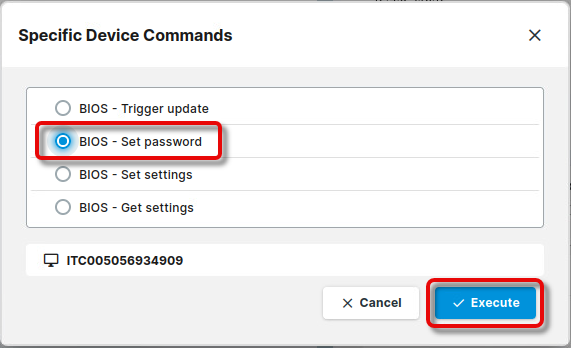
Command Line Interface (CLI) for the BIOS Tools
To test the BIOS update on a single device, you can use the command line tool as an alternative to the Specific Device Commands from the UMS.
As a prerequisite, the steps described under Setting up the File Source and the relevant settings in the profile must be completed.
When the command has been executed, a dialog informs you that a reboot is required. You can choose between two options:
Perform the reboot and update right away
Postpone the update to the next reboot
Usage
callBiosTools [OPTIONS] COMMAND [ARGS]...
Options
Option | Description |
|---|---|
| |
| |
| |
| Show this message and exit |
Commands
Command | Argument | Description |
|---|---|---|
| Set BIOS password | |
| Handle BIOS settings | |
| Configure BIOS settings with a configuration file | |
| Get current BIOS settings | |
| Show this message and exit | |
| Handle BIOS update | |
| Enable BIOS update. The update will be triggered after a reboot. | |
| Disable BIOS update | |
| Show if BIOS update is enabled or not | |
| Show this message and exit |
